Human responses to upright tilt: a window on central autonomic integration
- PMID: 10332107
- PMCID: PMC2269357
- DOI: 10.1111/j.1469-7793.1999.0617t.x
Human responses to upright tilt: a window on central autonomic integration
Abstract
1. We examined interactions between haemodynamic and autonomic neural oscillations during passive upright tilt, to gain better insight into human autonomic regulatory mechanisms. 2. We recorded the electrocardiogram, finger photoplethysmographic arterial pressure, respiration and peroneal nerve muscle sympathetic activity in nine healthy young adults. Subjects breathed in time with a metronome at 12 breaths min-1 (0.2 Hz) for 5 min each, in supine, and 20, 40, 60, 70 and 80 deg head-up positions. We performed fast Fourier transform (and autoregressive) power spectral analyses and integrated low-frequency (0.05-0.15 Hz) and respiratory-frequency (0. 15-0.5 Hz) spectral powers. 3. Integrated areas of muscle sympathetic bursts and their low- and respiratory-frequency spectral powers increased directly and significantly with the tilt angle. The centre frequency of low-frequency sympathetic oscillations was constant before and during tilt. Sympathetic bursts occurred more commonly during expiration than inspiration at low tilt angles, but occurred equally in expiration and inspiration at high tilt angles. 4. Systolic and diastolic pressures and their low- and respiratory-frequency spectral powers increased, and R-R intervals and their respiratory-frequency spectral power decreased progressively with the tilt angle. Low-frequency R-R interval spectral power did not change. 5. The cross-spectral phase angle between systolic pressures and R-R intervals remained constant and consistently negative at the low frequency, but shifted progressively from positive to negative at the respiratory frequency during tilt. The arterial baroreflex modulus, calculated from low-frequency cross-spectra, decreased at high tilt angles. 6. Our results document changes of baroreflex responses during upright tilt, which may reflect leftward movement of subjects on their arterial pressure sympathetic and vagal response relations. The intensity, but not the centre frequency of low-frequency cardiovascular rhythms, is modulated by the level of arterial baroreceptor input. Tilt reduces respiratory gating of sympathetic and vagal motoneurone responsiveness to stimulatory inputs for different reasons; during tilt, sympathetic stimulation increases to a level that overwhelms the respiratory gate, and vagal stimulation decreases to a level below that necessary for maximal respiratory gating to occur.
Figures

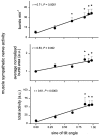
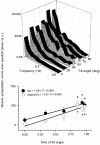
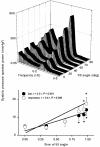
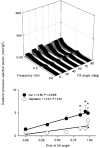
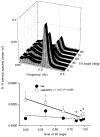
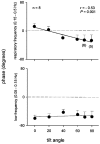
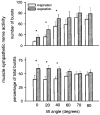

Comment in
-
Autonomic integration: the physiological basis of cardiovascular variability.J Physiol. 1999 Jun 1;517 ( Pt 2)(Pt 2):316. doi: 10.1111/j.1469-7793.1999.0316t.x. J Physiol. 1999. PMID: 10332083 Free PMC article. Review. No abstract available.
References
-
- Akaike H. Fitting autoregressive models for prediction. Annals of the Statistical Institute of Mathematics. 1969;21:243–247.
-
- Asmussen E. The distribution of the blood between the lower extremities and the rest of the body. Acta Physiologica Scandinavica. 1943;5:31–38.
-
- Banner NR, Williams M, Patel N, Chalmers J, Lightman SL, Yacoub MH. Altered cardiovascular and neurohumoral responses to head-up tilt after heart-lung transplantation. Circulation. 1990;82:863–871. - PubMed
-
- Cerutti C, Barres C, Paultre C. Baroreflex modulation of blood pressure variability and heart rate variabilities in rats: assessment by spectral analysis. American Journal of Physiology. 1994;266:H1993–2000. - PubMed
Publication types
MeSH terms
Grants and funding
LinkOut - more resources
Full Text Sources
Other Literature Sources
Medical
Miscellaneous

